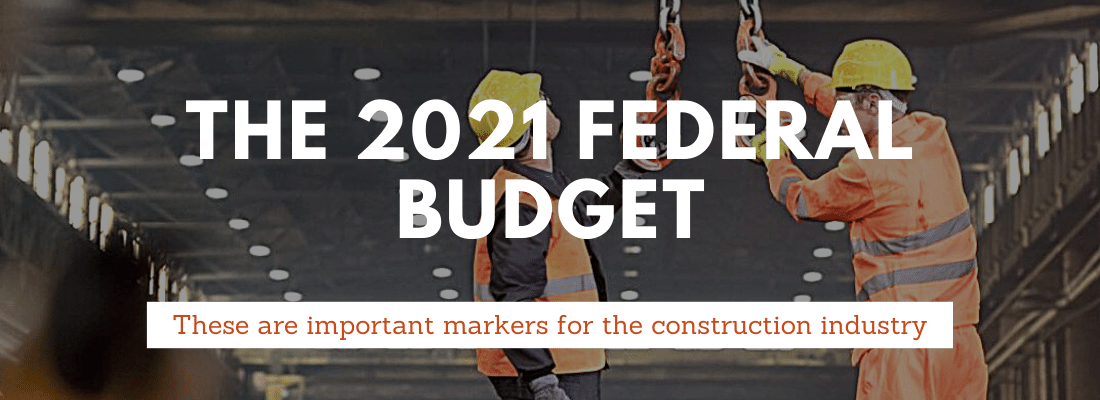This Budget Represents a Starting Point For the Healing
These Are Important Markers for the Construction Industry
Hellen Christodoulou, PH.D. Ing., B.C.L., LL. B, M.B.A
Helping Employers Train and Recruit Workers
- Budget 2021 proposes to provide $470 million over three years, beginning in 2021-22, to Employment and Social Development Canada to establish a new Apprenticeship Service. The Apprenticeship Service would help 55,000 first-year apprentices in construction and manufacturing Red Seal trades connect with opportunities at small and medium-sized employers. Employers would be eligible to receive up to $5,000 for all first-year apprenticeship opportunities to pay for upfront costs such as salaries and training.
Certain sectors like health, clean tech, and construction have grown and are struggling to find workers with the right skills to fill jobs.
- Budget 2021 proposes to provide $960 million over three years, beginning in 2021-22, to Employment and Social Development Canada for a new Sectoral Workforce Solutions Program. Working primarily with sector associations and employers, funding would help design and deliver training that is relevant to the needs of businesses, especially small and medium-sized businesses, and to their employees. This funding would also help businesses recruit and retain a diverse and inclusive workforce. This investment will help connect to 90,000 Canadians with the training they need to access good jobs in sectors where employers are looking for skilled workers.
Creating New Opportunities for Skilled Tradespeople
Since 2014, Canada has seen a decline in new apprentices for well-paying middle-class jobs. In 2019, it was estimated Canada needs to attract 167,000 new apprentices over the next five years just to align with existing levels of demand.
Every year, the Government of Canada provides about $90 million through 60,000 grants to support apprentices—but more is needed to ensure that those apprentices can find valuable work experiences and that employers can tap into this pool of skilled workers.
- Budget 2021 proposes to provide $470 million over three years, beginning in 2021-22, to Employment and Social Development Canada to establish a new Apprenticeship Service. The Apprenticeship Service would help 55,000 first-year apprentices in construction and manufacturing Red Seal trades connect with opportunities at small and medium-sized employers.
Employers would be eligible to receive up to $5,000 for all first-year apprenticeship opportunities to pay for upfront costs such as salaries and training.
Leveraging Procurement Opportunities
Since the Government of Canada is one of the largest public buyers of goods and services in the country, procurement policy is a fundamental lever to achieve social and economic objectives.
- Budget 2021 proposes to provide Public Services and Procurement Canada $87.4 million over five years starting in 2021-22, and $18.6 million ongoing. This funding will be used to modernize federal procurement and create opportunities for specific communities by diversifying the federal supplier base. Specifically, Public Services and Procurement Canada would:
- In addition, in order to demonstrate to Canada’s trading partners, the importance of balanced procurement opportunities, the government will pursue reciprocal procurement policies to ensure that goods and services are only procured from countries that grant Canadian businesses a similar level of market access. This will protect Canadian supply chains and ensure that Canada’s trading relationships are mutually beneficial economic relationships.
Removing Barriers to Internal Trade
For too long, trade barriers within our own country have held back Canadian businesses from reaching the full force of the Canadian market. Removing barriers to trade between provinces and territories will help build a more prosperous economy—creating jobs, fueling business expansion, expanding consumer choice of Canadian goods and services, and helping regional economies grow.
- Budget 2021 proposes to allocate $21 million over three years, starting in 2021-22, to:
- Work with provincial and territorial partners to enhance the capacity of the Internal Trade Secretariat that supports the Canadian Free Trade Agreement in order to accelerate the reduction of trade barriers within Canada.
- Advance work with willing partners towards creating a repository of open and accessible pan-Canadian internal trade data to identify barriers, including licensing and professional certification requirements, so that we can work together to reduce them.
Strengthening Canada’s Trade Remedy System
Maintaining a robust trade remedy system will ensure Canadian businesses can fully participate in the economic recovery and mitigate the impacts of unfairly traded imports.
- Budget 2021 announces the government’s intention to launch public consultations on measures to strengthen Canada’s trade remedy system and to improve access for workers and small and medium-sized enterprises (SMEs). This may result in proposed amendments to the Special Import Measures Act and the Canadian International Trade Tribunal Act.
Renewing our National Trade Corridors
Canada needs to address capacity constraints, bottlenecks, and inefficiencies in our own transportation infrastructure. This will support businesses across our supply chains and boost the potential for small and medium-sized businesses in all regions, including rural and remote communities.
- Budget 2021 proposes to invest $1.9 billion over four years, starting in 2021-22, to recapitalize the National Trade Corridors Fund. This funding could attract approximately $2.7 billion from private and other public sector partners, resulting in total investments of $4.6 billion. This would spur investments in much-needed enhancements to our roads, rail, and shipping routes, build long-term resilience for the Canadian economy, and support internal trade. Of this total funding, 15 per cent would be dedicated to building and improving transportation networks in Canada’s North.
National Infrastructure Assessment
Twenty-first century energy systems, public buildings, broadband networks, roadways, public transit, and natural spaces all contribute to our long-term economic productivity and prosperity. But smart, resilient public infrastructure projects also require careful planning. To support Canada’s long-term infrastructure planning:
- Budget 2021 proposes to provide $22.6 million over four years, starting in 2021-22, to Infrastructure Canada to conduct Canada’s first ever National Infrastructure Assessment. The assessment would help identify needs and priorities for Canada’s built environment.
Bonaventure Expressway
For nearly 20 years, the City of Montréal has envisioned converting the Bonaventure Expressway into an urban boulevard and restoring public access to the St. Lawrence River.
- Through Budget 2021, the government is announcing its intention to work with the City of Montréal to redevelop the Bonaventure Expressway, including exploring the merits of divesting the federal portion of the Bonaventure Expressway.
Canada’s National Capital Region
- Budget 2021 proposes to provide $35 million over five years, starting in 2021-22, to the National Capital Commission to support the acquisition and upkeep of federal assets, green infrastructure, and spaces in the National Capital Region.
Interprovincial bridge crossings serve as important connections in the nation’s capital. Building on the work of the long-term integrated interprovincial crossing plan led by the National Capital Commission, a dedicated project office responsible for addressing the need for an additional NCR crossing will be established at Public Services and Procurement Canada, jointly with the National Capital Commission.









